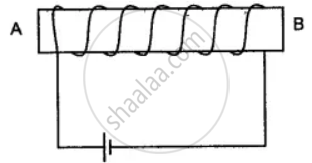Advertisements
Advertisements
Question
When a bar magnet is pushed towards (or away) from the coil connected to a galvanometer, the pointer in the galvanometer deflects. Identify the phenomenon causing this deflection and write the factors on which the amount and direction of the deflection depends. State the laws describing this phenomenon.
Solution
When a bar magnet is pushed towards (or away) from the coil connected to a galvanometer, the pointer in the galvanometer deflects because of the phenomenon of electromagnetic induction.
Factors on which the amount and direction of deflection depend are
(i) Speed of the magnet
(ii) Polarity of the magnet
Laws describing electromagnetic induction are
(1) Faraday’s law of electromagnetic induction: The magnitude of the induced emf in a circuit is equal to the time rate of change of magnetic flux through the circuit.
`epsilon=-(dphi)/dt`
(2) Lenz’s law: The polarity of induced emf is such that it tends to produce a current which opposes the change in magnetic flux that produced it.
APPEARS IN
RELATED QUESTIONS
What is electromagnetic induction?
Name two devices in which electromagnets are used and two devices where permanent magnets are used.
What condition is necessary for the production of current by electromagnetic induction?
In which of the following case does the electromagnetic induction occur?
A loop of wire is held near a magnet.
Welders wear special goggles or face masks with glass windows to protect their eyes from electromagnetic radiations. Name the radiations and write the range of their frequency.
Fill in the blanks by writing (i) Only soft iron, (ii) Only steel, (iii) Both soft-iron and steel for the material of core and/or magnet.
A. C. generator______.
You have been provided with a solenoid AB.

(i) What is the polarity at end A?
(ii) Give one advantage of an electromagnet over a permanent magnet.
The diagram shows a rectangular coil ABCD, suspended freely between the concave pole pieces of a permanent horseshoe magnet, such that the plane of the coil is parallel to the magnetic field.

(i) State your observation, when current is switched on.
(ii) Give an explanation for your observation in (i).
(iii) State the rule, which will help you to find the motion of rotation of coil.
(iv) In which position will the coil ultimately come to rest?
(v) State four ways of increasing the magnitude of force acting on the coil.
Ansari Sir was demonstrating an experiment in his class with the setup as shown in the figure below.

A magnet is attached to a spring. The magnet can go in and out of the stationary coil. He lifted the Magnet and released it to make it oscillate through the coil.
Based on your understanding of the phenomenon, answer the following question.
What will be observed when the Magnet starts oscillating through the coil. Explain the reason behind this observation.
Ansari Sir was demonstrating an experiment in his class with the setup as shown in the figure below.

A magnet is attached to a spring. The magnet can go in and out of the stationary coil. He lifted the Magnet and released it to make it oscillate through the coil.
Based on your understanding of the phenomenon, answer the following question.
Consider the situation where the Magnet goes in and out of the coil. State two changes which could be made to increase the deflection in the galvanometer.
